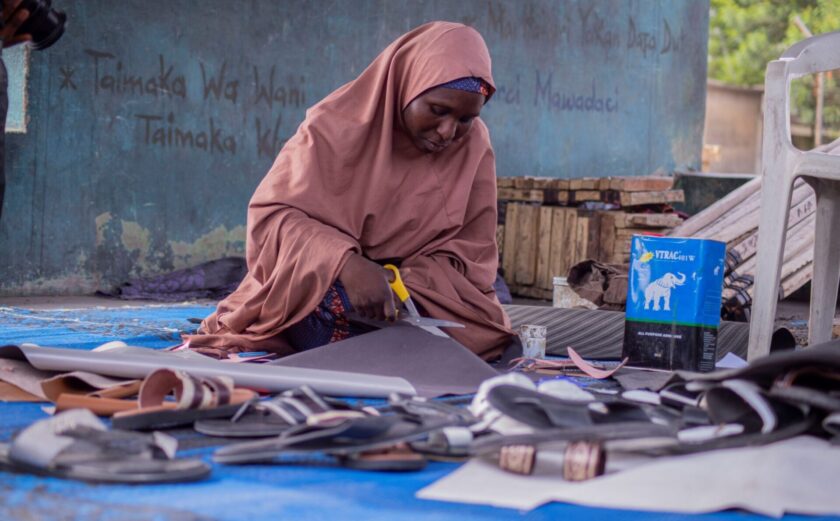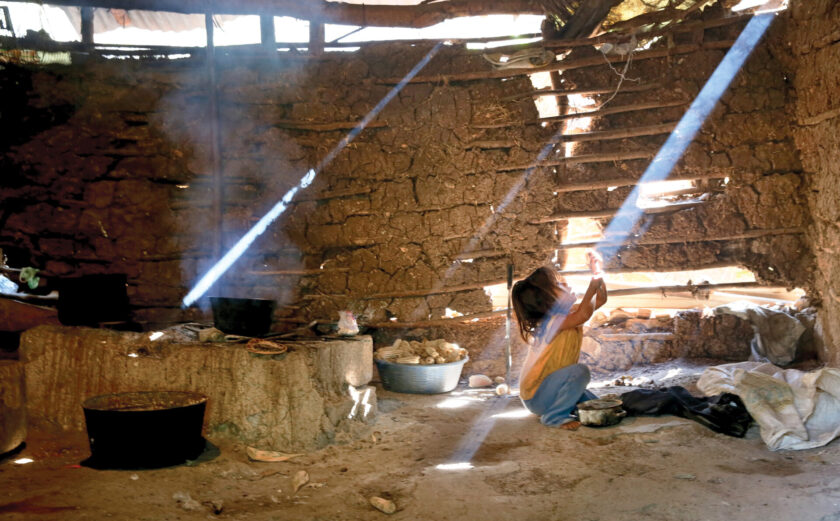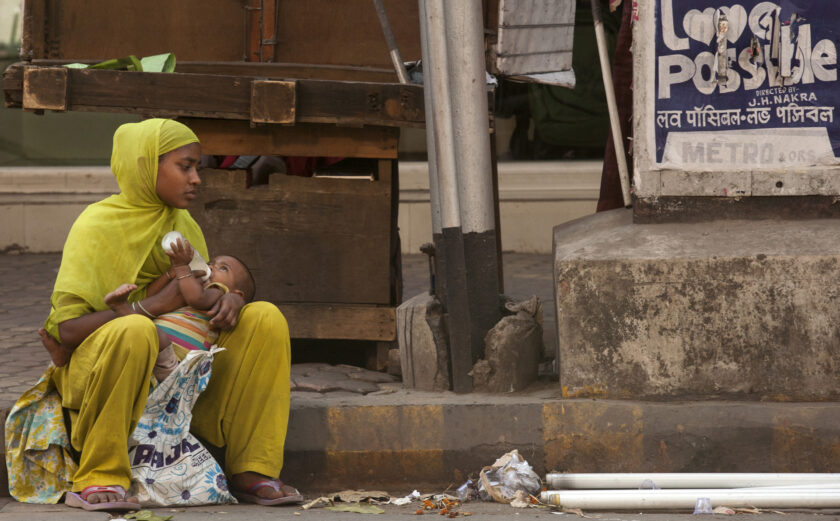
The Challenges Facing Tomorrow’s Humanitarians
Patricia McIlreavy's Remarks at Villanova University’s International Development and Humanitarian Relief Meetup
On November 7, 2019, Patricia McIlreavy, InterAction’s Vice President of Humanitarian Policy and Practice, delivered the keynote address at Villanova University’s International Development and Humanitarian Relief Meetup.
The event convened professionals in the humanitarian aid, development, and relief sector to discuss their experiences and teach interested students about work in the field. An experienced practitioner, Patty spoke about the global trends most affecting humanitarians and advised those seeking to work in aid. The transcript of her remarks is below.
Thank you. It is an honor to be here today at Villanova University for your international development and humanitarian relief meetup.
I have the honor and privilege of leading the humanitarian policy and practice team at InterAction, the largest alliance of international non-governmental agencies in the United States.
Working in the sectors of development and humanitarian action is an incredibly powerful and direct way to make a global impact, a fact you know and in which you are showing interest by being here today.
It is far from the only way, as politics and funding are also key enablers—or detractors—to achieving success in eradicating poverty, avoiding or mitigating conflict, decreasing needs, and serving populations and countries on their path to development.
And so whatever path you may choose in your future, work to keep a humanitarian mindset.
For humanitarians can be either practitioners, like myself, or they can be anyone who believes in a world where it is important to save people’s lives, ease their pain and suffering, and preserve human dignity.
And the more people who believe in this world—whether they are walking the corridors of political power, engaging in a global financial world, working for the fifth estate, or some other walk of life—the more people who believe in a better world, the greater our chances of achieving it.
The current rise of populism, isolationism, and division—in our country and others across the globe—are at odds with true humanitarianism.
Humanitarianism is centered on the principles of neutrality, impartiality, independence, and humanity.
What does this mean? In simple terms, don’t take sides, don’t choose who is most in need based on factors other than need alone, make your own decisions, and address human suffering wherever you find it.
A tall order. And one that many humanitarians struggle to accomplish. As humanitarians are but themselves human, and all too often, we are seduced into taking sides or helping those who ‘appear’ most deserving, or working where our donor wants us to work.
And it is for this reason that we constantly strive to remind ourselves, to push ourselves and others on how best to achieve principled humanitarian action, and how to connect it in the best way possible with development goals and programming, so that sustainable, independent futures are available to people in need.
I want to talk with you today about three of the challenges facing tomorrow’s humanitarians. And to be honest, more and more, these same challenges are also facing tomorrow’s development actors. And while there are certainly more than three, understanding these three are a good place to start.
First, complexity—be it scale, security, operational space, or the capacities of organizations. Complexities create ever-present tensions.
The absolute scale of needs globally can be overwhelming.
As a society, we have never been as informed as we are right now. And yet, one must wonder if all this information is too much. Have we become numb to the scale of inhumanity on display globally?
And the data can be hard to process. So, let’s start with a few data points.
The number of migrants, or people residing in a country other than their country of birth, reached the highest ever recorded or 272 million, in 2019.
While many individuals migrate out of choice, many others migrate out of necessity.
Of the people on the move, 70.8 million are fleeing war, persecution, and conflict.
This is the highest number ever recorded since the U.N. High Commissioner for Refugees was formed 70 years ago.
The number of forcibly displaced is double the level from 20 years ago. Double.
And it is comprised of 26 million refugees, 3.5 million asylum seekers, and over 41 million internally displaced persons, or IDPs—people who have fled within their own country.
And yet the almost 71 million who have fled conflict are not the entirety of people in need globally.
According to the United Nations’ Office of the Coordination of Humanitarian Assistance, which supports the coordination of responses worldwide, there are nearly 132 million people in 42 countries in need of international humanitarian assistance.
And yet even this number is not inclusive of people in need within countries deemed as able to aid themselves without the benefit of external assistance.
For example, the millions of Americans affected by hurricanes, wildfires, floods, or severe storms every year, this is estimated by FEMA to be an additional 141 million people.
And while we don’t count them within our calculations for international response requirements, this large number of Americans in need do still have an impact on international responses.
This happens in three ways: one, potential donors will often give closer to home than to the emergencies far away; two, emergencies closer to home overshadow all other crises, even ones with a more staggering human scale, and draw media attention and political will away from international crises; and three, if a domestic crisis is severe enough, the traditional large international NGOs will respond. And this additional domestic response can pull on an organization’s capacities and funding.
Now let’s turn to costs.
According to the U.N.’s Financial Tracking System website, the total budget need for active international responses is over $26.5 billion. And to be clear, this is only for response, not for the incredibly important phases of rebuild, stabilize and develop.
And at this late point in 2019, only 54.7% of this appeal is funded, with $14.5 billion provided by member states.
Beyond the gaps in the appeal number, there is also a gap in member states sharing responsibility for supporting the responses, with the majority of that pledged coming from only 10 countries globally, with the U.S. being the most generous, providing 6 billion.
If you’re like me, a $6 billion donation, much less the full $26.5 billion needed, may seem like rather unfathomable numbers. Too high to achieve in a year. And beyond the capacity of any one country to make a difference.
Until you compare it with other things, for example, let’s look at the cost of Halloween. Last year, Americans spent $9.1 billion on Halloween. Think on that a moment.
9.1 billion dollars on decorations, candy, and costumes. More than half the total already provided by donors against the global humanitarian appeals for 42 countries.
Now I’m not against Halloween, but it blows me away that for the cost of three Halloweens, the U.S. public ALONE could more than cover the costs of all the current appeals internationally.
And on a more individual level—the entire U.S. contribution of $6 billion is equivalent to one month of Jeff Bezos’ income. One month.
But the responsibility of funding global humanitarian appeals does not fall on the U.S. public. Or Jeff Bezos.
And while I’d love for the U.S. government to give more—as in reality, less than 1% of our federal budget goes to poverty-focused international development aid and humanitarian assistance—I’d also like to see other countries pick up a greater responsibility in funding humanitarian needs across the globe.
For even with that less than 1% of the federal budget set aside for poverty-related assistance, the U.S. remains one of the largest global donors to the United Nations and the international and national organizations that work in partnership together to aid people in need.
Unfortunately, the global needs for funding of humanitarian responses continue to outstrip the supply from countries and individuals.
Further to the growing scale in numbers of people in need, and the costs of responses, there are additional complexities at play.
Access to populations, and more importantly, of populations to services continues to be an increasing challenge.
The largest impediment to principled humanitarian action in present crises is the intentional obstruction, harassment, and even targeting of humanitarians by warring parties, including governments.
Adherence to legal frameworks and norms has eroded substantially, with attacks against civilians and civilian infrastructure occurring in ever-increasing numbers.
Security is also a significant factor. 2018 saw the second-highest number of aid worker attacks on record. A total of 405 aid workers were affected by major violence in 226 separate incidents. And the number of attacks on national aid workers continues to rise.
Donor regulations, set up often to appease parliaments and taxpayers, are increasingly restrictive and politicized. With zero-tolerance approaches to fraud, harassment and diversion are being taken in high-risk environments, which by their very nature, carry increased levels of risk factors.
The Lake Chad Basin clause is an example of the new crop of regulations that are put in place as window dressing—to show that the government is taking counter-terrorism seriously, but in a way that is almost impossible to implement. The LCB notes that aid is not to be provided to any affiliates of Boko Haram, the terrorist movement in the northeast. Yet, what does affiliate mean? The closest we have gotten to clarity is six months. So if you have the misfortune to be kidnapped, and possibly raped or forced to harm others, you have six months to get away. Because at six months and a day, you are now deemed as supportive of your captors and no longer eligible for assistance.
Another factor within complexities is our capacity to respond to the number of concurrent protracted crises.
The World Bank estimates that the average length of displacement for refugees is ten years, and conflict-related internal displacement lasts an average of 23 years.
The challenge for humanitarians to continue to work with populations in need—long after the headlines are gone—means that organizations are overstretched, with gaps in staffing and programming.
Evidence of the human resource demands on the sector is obvious through the number of positions open on humanitarian job-seeking websites. For example, ReliefWeb currently lists 2725 open jobs, with the majority requiring over three years’ experience.
Once again, we see need outstripping the supply.
All in all, the challenge of complexities, in the many dimensions I’ve outlined, makes me very glad that I started my career 25+ years ago, when our approaches were much simpler, even if less professional and less efficient.
Secondly, there is a Protection crisis that continues to grow and expand.
International organizations work more and more in fragile states and conflict settings. And yet too often, insufficient investment in protection analysis results in limited context-specific strategies.
Additionally, local actors and the people who are directly affected by crises are too often left out of analysis and design efforts.
We need to respond better to affected people’s own assessment of their threat environment and contribute to the protective outcomes the people themselves define.
Recently I was in Afghanistan, and in discussions with communities was surprised again and again on how we—as a system—are not listening well enough to communities. They know the solutions required; we need to be open enough to hear them. And brave enough to challenge the status quo to push for those solutions.
For example, my colleague and I met a young mother whose son was disabled due to an accident. At the time of the original accident, they had no access to health services due to the conflict. This forced them to move to a new location, where they found that services also were not available. This then caused them to sell their assets—the father’s rickshaw—and thus their independent livelihood—to gather funds to make a trip across the border to services in Pakistan. However, to their knowledge, recurring care is not available in their town of Maimana, and so they are now suing her father’s family to sell her inherited land so she can raise more funds for additional travel—this time to India—and care for her son.
But when we returned to Kabul, we learned that there are services available and accessible a lot closer than across borders, but communities are either unaware or so scared of political issues—especially if they village of origin is in Taliban held areas—that they do not know of or seek them. And so a family drives itself further and further into poverty.
And we heard replications of this story again and again. Families selling their children to gain funds to pay for basic needs. They can’t get work. Or land for farming or whatever it may be.
Why? To get the appropriate status to be more than ‘displaced’ and thus with limited rights, they need a permit, and the permits are only issued back at their state of origin.
Yet, their place of origin is under Taliban control and a return to which potentially brings great risks as they will be seen as having fled to government-held areas.
So we know that community-based development programs are needed, and we know that solutions that address the root causes of these situations are feasible, but everyone—governments, the U.N., the NGOs—is eager to see that which they want to see—which is a Government-led development response focused on larger infrastructure needs.
To this end, as humanitarian and development workers, we need to ensure that our own desires to work with governments on long-term development strategies do not leave us blinded to inequalities and rights violations.
These situations are the Achilles’ heel of sustainable development and healthy governance, and we ignore them at the peril of populations at risk.
If we truly put people at the center of our programs, and if we are to be accountable to them, we must be driven by the solutions they design to accommodate their needs.
And at times, this may mean that we have uncomfortable conversations with donors or governments on behalf of the people.
Closely aligned to the protection crisis is the growing erosion of armed actors’ compliance to international humanitarian law. IHL is a set of rules that seek to limit the effects of armed conflict. It protects people who are not or are no longer participating in hostilities and restricts the means and methods of warfare.
Even as conflicts and threats change, the norms remain relevant and critical, yet violations occur with impunity. We cannot allow the belief that the ends justify the means to become pervasive in society.
To do so, diminishes us all.
We must call for international leadership to end conflicts. We are at an odd moment in time –a rise of populism and sovereignty threaten both the leadership of individual nations and the multilaterals that traditionally pushed for peace and stability.
Without political solutions, there can be no sustainable solutions for countries in conflict. The intractability of the open conflicts in Yemen, Syria, and South Sudan will continue, alongside the suffering of their people.
Lest we forget, there are also slow burns that garner less international attention but have as high, if not a higher human cost: Myanmar, the Democratic Republic of Congo, and Nigeria. And the crises which we do not hear of and possibly assume are over—Central African Republic, Somalia, Afghanistan, Sudan.
Beyond the internal crises are the refugee ones, often interconnected, and where we are seeing increased barriers to asylum, decreased appetite for resettlement, and a new phenomenon of the wealthy outsourcing global responsibilities to poorer countries.
While the generosity of host countries such as Jordan and Uganda are to be commended, the world’s leaders must own their collective responsibilities to find long-term solutions to the crises that have caused populations to flee across borders.
Protection concerns have also arisen as we attempt to be more specific in defining population categories—refugees, displaced, stateless persons, migrants—and yet the truth is often people’s situations are not so simple as a category.
Bangladesh sees the Rohingya as stateless people, not refugees. The European Union sees the Syrian refugees landing on their shores as migrants. All too often, governments use categories not to define people’s needs but to limit their own responsibilities.
The regional dimension of conflicts also creates challenges—for example, in the Sahel, you have refugees, migrants, and displaced all mixed together as they flee Boko Haram, as well fleeing the various heavy-handed military responses to Boko Haram.
We need to get better at dismantling categories and mandates and better at determining aid based on people’s need. To do this, we need to focus on collective outcomes and results.
And these outcomes must go beyond the traditional life-saving needs as defined for decades. The truck and chuck approach is loved by many, especially the media and private donors as it provides for a great photo op, or even a nice report—see, we have delivered aid to people.
That is natural; it provides a clear and rapid accountability—you can see that people are getting something.
And it is true—water, health, food, shelter—all are necessary but are not nearly enough for a population to feel safe and secure enough to able to return to a level of normalcy. We must maintain the importance of protection solutions—from the immediate all the way to root causes—within our program approaches.
And we must explore how to shift from a mentality of delivery to enabling people to decide on what their priorities may be, as is evidenced by the growing support for cash distributions in lieu of goods.
The third challenge facing us is partnerships. Partnerships was a key theme at the World Humanitarian Summit in Istanbul in 2016. International organizations all know and believe in the push for greater localization and ownership.
We also know though that this is harder than a commitment—systems, funding mechanisms, compliance regulations, accountabilities and biases—whether overt or no—all play a role in diminishing our ability to truly partner.
We need to develop the capacities within international organizations to partner better with national actors. We must also explore the benefits of partnering with the private and technology sectors.
We need to adapt our culture to be more accepting and willing to partner.
An important key to our success, and probably the hardest, will be how well check our own hubris.
We already recognize that the people best suited to serve populations in need are often those closest to them. We must stop merely saying these words and put our professed beliefs into practice.
In closing:
I want to reiterate that despite the future challenges facing us, humanitarian actors and humanitarian action is at its most effective and impactful. As a collective, we are better at identifying needs in crises, and we are quicker to respond.
And that while the challenges I’ve outlined are complex, very few of the solutions are in the hands of humanitarians to provide alone.
What we—as humanitarians—can do is provide is greater honesty of the human cost of not seeking the most appropriate solution.
And I look forward to possibly working alongside some of you on the solutions to the challenges presented as you explore your own future careers.
Thank you.








